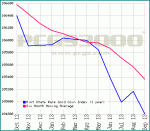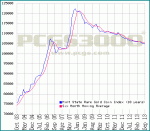I always welcome email from readers and the curious but I received an email with an interesting question. My correspondent had become interested coin collecting as an investment and wanted to know if I knew where to find out how much the gold coins would be worth in 10 or 20 years. Channeling my inner Edward Moore (from his play The Gamester) or Dr. McCoy for the Star Trek fans, I replied “If anyone knew the answer to that question they would rich beyond the dreams of avarice!”
This is not the first time someone asked me what I thought would be the price of rare or gold coins in the future. It is also a question that I do not like to answer since I am a collector and not an investor.
Markets are difficult to predict. Even the experts get it wrong. For example, a simple Internet search will find articles that appeared in MarketWatch, Reuters, and The Guardian from the United Kingdom predicting $2000 per ounce prices for gold. In March, the financial site The Motley Fool had an article saying that gold could hit $2000 per ounce next year.
In reality, gold opened the year at 1670.95, the high for 2013 and is 1309.64 as of Friday’s (October 25) close. Even with a small spike in August, the trend is going down. But does the trend mean that gold will still go down?
Trying to read the financial tea leaves has long been a sport for the financial pundits. One pundit writing for Forbes noted that the dollar strengthened while gold and crude oil dropped while last week, another pundit from Bloomberg wrote that stocks and gold rose as the dollar falls on the reaction earnings that have been topping estimates and the prediction of slower economic growth predicted by the Federal Reserve saying it will maintain its stimulus program. In between, an analyst at Yahoo Finance was predicting “a major turnaround in the US Dollar versus the Euro, but gold prices may actually outperform versus the Greenback.”
Predicting the price of gold and rare coins can be a similar test of ones nerves. One interesting way to look at the market is to see what the PCGS3000 Index says. The PCGS3000 index uses a sampling of collector coins, type coins, varieties, and differing grades to create a market index. Their sample are considered classic coins (1792-1964) including gold and early commemoratives to total 3000 coins.
This recent history of collector coins shows an upward trend over the last year as the economy has improved (see graph below on the left). However, looking over the last 10 years (graph below on the right) the peak occurred before the economy turned sour at the end of 2008 and has largely remained flat since falling to a low in 2010.
- PCGS3000 one year graph showing an upward trend
- PCGS3000 ten year chart showing the unpredictability of the coin market
Does this mean gold and rare coins are not a good investment? If you bough during the run up in value in 2008, you are behind. However, coins purchased from the beginning of the ten-year chart should yield a better return for investors.
Those thinking that gold coins may be a better investment might want to consider that the price of their coins will be tied to the price of gold. Both the PCGS Generic Gold Coin Index (below on the left) and the PCGS Mint State Rare Gold Coin Index (below on the right) almost mirrors the gold market over the last year. In fact, looking at the 10 year history the Mint State Rare Gold Coin Index almost mirrors the PCGS3000 Index while the Generic Gold Coin Index is all over the place and does not even follow the price of gold for the last 10 years.
- PCGS Generic Coin Index for the past year
- PCGS Mint State Rare Gold coins showing a downward trend
- PCGS Generic Gold Index for the last 10 years shows almost no trend
- PCGS Mint State Rare Gold Index seems to mirror the PCGS3000 index.
While you are thinking that this may be particular to gold coins, investors in 20th Century Coins (see chart below on the left) and Morgan and Peace Dollars (below, right) may be scratching their heads looking for a better return.
- PCGS Morgan and Peace Dollar Index for the last 10 years
- PCGS 20th Century Coin Index may indicate that coins from our recent past may not be a good investment.
As a layman, what appears to be a hot market is the very high end market. These are the extremely rare coins, coins with extraordinary pedigrees, and unique collectibles. Not every collector or investor is going to be able to own a 1794 Flowing Hair dollar that sold for $10 million last January, the George Walton 1913 Liberty Head Nickel, or a 1880 Coiled Hair Stella which is really a pattern that sold for $2.5 million in September. Even rare copper coins are selling at a premium.
The mantra of investing is to buy low and sell high. The problem is knowing what to buy. By the time someone figures out what is the best investment, the prices are going up and the investor value is lost. Along with knowing the coins and their value, timing is everything. For example, is now the time to look at what are sometimes called exotic U.S. coins? Exotic coins are those produced before the 1870s like the Bust and Liberty Seated coins, Trade dollar, and even the rare two- and three-cent coins. Many of these coins are overlooked by a lot of people, including collectors, sometimes because of cost other times because they are not as readily available.Predicting the coin market is more difficult than stocks and commodities. With the capital markets there is company performance data, yield of crops, world conditions, and a lot of measurable factors that the professionals use. None of that exists in the coin investing market. Prices can be predicted by rarity to a certain degree, much of the pricing appears to be based on emotion: what will you pay for the coin. For instance, if the 1794 Flowing Hair dollar sold for $10 million what would the only legal-to-own 1933 Saint Gaudens Double Eagle sell for today? It used to hold the record for the most ever paid for a single coin when it sold at auction for $7,590,020 (including buyers premium and the $20 that was required to monetize the coin) in 2002.
In case you were interested, according to the Bureau of Labor Statistics CPI Inflation Calculator, adjusted for inflation, the price paid for the 1933 Double Eagle in 2002 is $9,867,321.33 in 2013 dollars. Even adjusted for inflation, the price does not beat the 1794 dollar!
If you are interested in trying to test this market, I wish you well. I am a coin collector not an investor. I do not think that will change. However, if you are looking for an interesting investment market, I hear the market for classic cars, including the muscle cars of the 1960s and 1970s are an affordable and growing market. And if you do not want to enter that market for investment, at least you can consider an emotional purchase—like I did!













Excellent piece. I have argued many times in my writings that it is difficult to make money on coins other than at the very high end of the market that most of us can’t afford. Sometimes, as you suggest, if your timing is right, you can do well with bullion-based coins, or with hot modern coins before they cool off, but in general it is best not to have high expectations of price appreciation and to buy what you like and can afford.
when collectors figure out that the us mint made 20 different versions of the 2006w unc silver eagle with w mintmark to cel. the 20th anni. this will put each version at a mintage of around 23,000 the subset is very had to put together.some have the same finish on both sides and some and some have two dif finishes on. each version. judge for yourself .It has taken us 7 years to put 2 subsets together